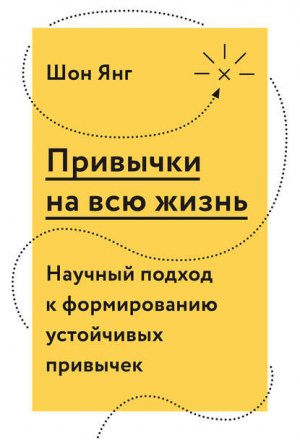ѕривычки на всю жизнь. Ќаучный подход к формированию устойчивых привычек янг Ўон

—пасибо вам, мои наставники и коллеги по алифорнийскому университету. ќсоба€ благодарность Ѕобу аплану, “ому оутсу и —тиву Ўопто, которые привели мен€ в этот университет, а также другим моим коллегам и наставникам, докторам —тиву Ёллису из »сследовательского центра Ёймса, ƒжеффри лауснеру, ƒжину Ѕлоку, рису олуэллу, јлексу ’оффману, Ёлизару Ёскину, иту ’айнцерлингу, Ћилиан √елберг, ƒугу Ѕеллу, ƒжуди √ассон, ƒжону ’айатту, ћорин ”олтон, Ёрин Ѕонар, ’осе Ѕаумайстеру, ѕатрику —алливану, ’ендриксу Ѕрауну и Ѕрайану ћустански. —пасибо вам, √лори€ ¬аргезе, Ёлисон ќркин, ип антело и этический комитет алифорнийского университета за вашу поддержку и отзывы.
—пасибо моим сотрудникам и студентам в »нституте прогностических технологий алифорнийского университета (UCIPT), особенно профессорам ¬ею ¬ангу, ћайку эри, јмарнату √упте, —тефани —тратди, ристин иркпатрик, ¬ассилису “ротрасу, „ену Ћи, ƒжеймсу ‘аулеру и ¬агелису ’ристидису. —пасибо моей исследовательской группе и студентам, которые помогали проводить исследовани€ и давали отзывы: ирану √иллу, ’аркирану √иллу, ƒжастину “омасу, Ћинвуду Ћорду, —анаму Ўамтоби и многим, многим другим. ќчень признателен ƒэвиду Ѕычкову за колоссальную поддержку и веру в нашу работу.
я не смог бы обойтись без помощи спонсоров. Ёто –озмари ћаккейг, арли ”иль€мс, √рег √ринвуд, —юзанна Ёллисон, рис √ордон, Ёндрю ‘орсайт и многие другие в Ќациональных институтах здравоохранени€. ƒжонатан Ћи, Ёмма «оренски, ¬ай Ќгуен, Ѕриджет ”иль€мс из Basis/Intel; елли ”интерс из Facebook; ћарк ћакграт и команда AHF, а также арина ¬онг и Ёмили Ћоквуд из Gates Foundation, ћейер и –ене Ћаскин. —пасибо, что вдохновили мен€ написать эту книгу и поддерживали мою работу!
» последнее, но, безусловно, не менее важное. я хочу поблагодарить участников наших исследований, особенно лидеров наших онлайн-сообществ HOPE. ¬ы были насто€щим вдохновением дл€ мен€, и только благодар€ вашему стремлению делать благо дл€ общества € смог повли€ть на этот мир.
ѕримечани€ автора
√лава 1. Ќаука устойчивых изменений
ЛЛ1ЫЫ Nik Wallenda: About, http://nikwallenda.com/about-us/.
ЛЛ2ЫЫ Nik Wallenda, https://en.wikipedia.org/wiki/Nik_Wallenda.
ЛЛ3ЫЫ Diet Starts TodayЕ and Ends on Friday: How We Quickly Slip Back into Bad Eating Habits within a Few Days, Daily Mail, September 16, 2013, http://www.dailymail.co.uk/news/article-2421737/Diet-starts-today-ends-Friday-How-quickly-slip-bad-eating-habits-days.html.
ЛЛ4ЫЫ Dieting Does Not Work, UCLA Researchers Report, University of California at Los Angeles, April 3, 2007, http://newsroom.ucla.edu/releases/Dieting-Does-Not-Work-UCLA-Researchers-7832.
ЛЛ5ЫЫ Aurel O.†Iuga, and Maura J.†McGuire. Adherence and Health Care Costs, Risk Management and Healthcare Policy 7 (2014): 35Ц44.
ЛЛ6ЫЫ Bruce Jaspen. U.S. Workforce Illness Costs $576B Annually from Sick Days to WorkersТ Compensation, Forbes, September 12, 2012, http://www.forbes.com/sites/brucejapsen/2012/09/12/u-s-work-forceillness-costs-576b-annually-from-sick-days-to-workers-compensation/#4cba1ad27256.
ЛЛ7ЫЫ Ћична€ беседа с ƒжошем Ќавой, 14 феврал€ 2017 года.
ЛЛ8ЫЫ Ћична€ беседа с “омом —осноффом, 8 феврал€ 2016 года.
ЛЛ9ЫЫ Lars Osterberg, and Terrence Blaschke. Adherence to Medication, New England Journal of Medicine 353 (2005): 487Ц497.
ЛЛ10ЫЫ ” участников наших вмешательств дл€ устойчивых изменений был в два раза больший шанс изменитьс€ (44†% по сравнению с 20†% в одном исследовании и 17 и 7†% процентов в другом). ћы повторно обследовали эти группы через 15 мес€цев и обнаружили, что результаты сохранились. —м.: Enrique Rivero, Combo of Social Media, Behavior Psychology Leads to HIV Testing, Better Health Behaviors, last modified September 4, 2013, http://newsroom.ucla.edu/releases/behavioral-psychology-social-media-248056.
ЛЛ11ЫЫ Daily Routines, Ernest Hemingway, http://dailyroutines.typepad.com/daily_routines/2008/01/ernest-hemingwa.html.
ЛЛ12ЫЫ Antonella Gasbarri, Assunta Pompili, Mark G.†Packard, and Carlos Tomaz, Habit Learning and Memory in Mammals: Behavioral and Neural Characteristics, Neurobiology of Learning and Memory 114 (October 2014): 198Ц208.
ЛЛ13ЫЫ R.†B.†Zajonc, 1980. Feeling and Thinking: Preferences need no Inferences, American Psychologist 35, no. 2 (1980): 151Ц175.
√лава 2. Ћестница
ЛЛ1ЫЫ Brad Delson, https://en.wikipedia.org/wiki/Brad_Delson.
ЛЛ2ЫЫ Karen E.†Jacowitz and Daniel Kahneman, Measures of Anchoring in Estimation Tasks, Personality and Social Psychology Bulletin 21 (1995): 1161Ц1166.
ЛЛ3ЫЫ U.S. Government Printing Office. Day Trading: An Overview, September 16, 1999, http://www.gpo.gov/fdsys/pkg/CHRG-106shrg61159/html/CHRG-106shrg61159.htm; ЂDo 95†% of all traders lose?ї HubPages, April 29, 2011, https://hubpages.com/money/Do-95-percent-of-all-traders-lose.
ЛЛ4ЫЫ Jack D.†Schwager, Market Wizards: Interview with Top Traders (Hoboken, NJ: John Wiley & Sons, 2013).
ЛЛ5ЫЫ Alexander M.†Freud and Marie Hennecke, Changing Eating Behaviour vs. Losing Weight: The Role of Goal Focus for Weight Loss in Overweight Women, Psychology & Health 27, no. 2 (2012): 25Ц42.
ЛЛ6ЫЫ Shelley E.†Taylor, Lien B.†Pham, Inna D.†Rivkin, and David A.†Armor, Harnessing the Imagination: Mental Simulation, Self-Regulation, and Coping, American Psychologist 53, no. 4 (1998): 429Ц439. doi:10.1037/0003-066X.53.4.429.
ЛЛ7ЫЫ Lien B.†Pham and Shelley E.†Taylor, From Thought to Action: Effects of Process-Versus Outcome-Based Mental Simulations on Performance, Personality and Social Psychology Bulletin 25, no. 2 (1999): 250Ц260.
ЛЛ8ЫЫ Gabriele Oettingen, Positive Fantasy and Motivation, in The Psychology of Action: Linking Cognition and Motivation to Behavior, ed. P.†M.†Gollwitzer and J.†A.†Bargh, (New York: Guilford, 1996) 236Ц259.
ЛЛ9ЫЫ John R.†Doyle, Survey of Time Preference, Delay Discounting Models, Judgment and Decision Making 8, no. 2 (2013): 116Ц135.
ЛЛ10ЫЫ Philippe N.†Tobler, Christopher D.†Fiorillo, and Wolfram Schultz, Adaptive Coding of Reward Value by Dopamine Neurons. Science (New York, NY.) 307, no. 5715 (2005): 1642Ц1645, doi:10.1126/science.1105370.
ЛЛ11ЫЫ Tabla, http://en.wikipedia.org/wiki/Tabla.
ЛЛ12ЫЫ Lisa S.†Blackwell, Kali H.†Trzesniewski, and Carol Sorich Dweck, ЂImplicit Theories of Intelligence Predict Achievement Across an Adolescent Transition: A Longitudinal Study and an Interventionї Child Development 78, no. 1 (2007): 246Ц263, doi:10.1111/j.1467Ц8624.2007.00995.x.
ЛЛ13ЫЫ Rebecca L.†Shively, and Carey S.†Ryan, Longitudinal Changes in College Math StudentsТ Implicit Theories of Intelligence. Social Psychology of Education 16, no. 2 (2013): 241Ц56, doi:10.1007/s11218-012-9208-0.
ЛЛ14ЫЫ Second Life, http://en.wikipedia.org/wiki/Second_Life.
ЛЛ15ЫЫ Gustavo Saposnik, Mindy Levin, and for the Stroke Outcome Research Canada (SORCan) Working Group, Virtual Reality in Stroke Rehabilitation. Stroke 42, no. 5 (2011): 1380Ц1386, doi:10.1161/STROKEAHA.110.605451.
ЛЛ16ЫЫ Page L.†Anderson, Matthew Price, Shannan M.†Edwards, Mayowa A.†Obasaju, Stefan K.†Schmertz, Elana Zimand, and Martha R.†Calamaras, Virtual Reality Exposure Therapy for Social Anxiety Disorder: A Randomized Controlled Trial, Journal of Consulting and Clinical Psychology 81, no. 5 (2013): 751Ц760, doi:10.1037/a0033559.
ЛЛ17ЫЫ Creating Virtual Worlds to Train Your Salesforce, Direct Selling Education Foundation, May 16, 2012, http://dsef.org/creating-virtual-worlds-to-train-your-salesforce/.
ЛЛ18ЫЫ Sexy Nude Beach, Second Life, http://maps.secondlife.com/secondlife/Sexy%20Nude%20Beach/220/150/23.
ЛЛ19ЫЫ David R.†Bassett, Holly R.†Wyatt, Helen Thompson, John C.†Peters, and James O.†Hill, Pedometer-Measured Physical Activity and Health Behaviors in U.S. Adults, Medicine & Science in Sports & Exercise 42, no. 10 (2010): 1819Ц1825, doi:10.1249/MSS.0b013e3181dc2e54.
ЛЛ20ЫЫ Albert Bandura, Social Foundations of Thought and Action: A Social Cognitive Theory (Englewood Cliffs, NJ: Prentice Hall 1986).
ЛЛ21ЫЫ Linkin Park, http://en.wikipedia.org/wiki/Linkin_Park.
ЛЛ22ЫЫ Evan Polman, Effects of Self Ч Other Decision Making on Regulatory Focus and Choice Overload, Journal of Personality and Social Psychology 102 no. 5 (2012): 980Ц993, doi:10.1037/a0026966.
ЛЛ23ЫЫ MyFitnessPal Acquires Rock Health-Backed Coaching Startup, Sessions, Business Wire, February 19, 2014, http://www.business-wire.com/news/home/20140219005652/en/MyFitnessPal-Acquires-Rock-Health-Backed-Coaching-Startup-Sessions#.VKISyf8CAJQ.
√лава 3. —ообщество
ЛЛ1ЫЫ Devanie Angel, The Power of Cults, August 12, 2004, https://www.newsreview.com/chico/power-of-cults/content?oid=31494.
ЛЛ2ЫЫ Democratic Workers Party, https://en.wikipedia.org/wiki/Democratic_Workers_Party.
ЛЛ3ЫЫ Rebecca Schweier, Matthias Romppel, Cynthia Richter, Eike Hoberg, Harry Hahmann, Inge Scherwinski, Gregor Kosmtzky, and Gesine Grande, A Web-Based Peer-Modeling Intervention Aimed at Lifestyle Changes in Patients with Coronary Heart Disease and Chronic Back Pain: Sequential Controlled Trial, Journal of Medical Internet Research 16 no. 7 (2014): e177, doi:10.2196/jmir.3434.
ЛЛ4ЫЫ Karen Foster and Dale Spencer, ItТs Just a Social Thing: Drug Use, Friendship and Borderwork among Marginalized Young People, The International Journal on Drug Policy 24, no. 3 (2013): 223Ц230, doi:10.1016/j.drugpo.2012.12.005.
ЛЛ5ЫЫ Robert Downey, Jr., http://en.wikipedia.org/wiki/Robert_Downey_Jr.
ЛЛ6ЫЫ Udovitch, Mim. 2003. The Sobering Life of Robert Downey, Jr., The New York Times Magazine, October 19, http://www.nytimes.com/2003/10/19/magazine/the-sobering-life-of-robert-downey-jr.html?pagewanted=2.
ЛЛ7ЫЫ Sean D.†Young, A.†David Nussbaum, and Benoit Monin, Potential Moral Stigma and Reactions to Sexually Transmitted Diseases: Evidence for a Disjunction Fallacy, Personality and Social Psychology Bulletin 33, no. 6 (2007): 789Ц799, doi:10.1177/0146167207301027.
ЛЛ8ЫЫ Mark L.†Hatzenbuehler, Jo C.†Phelan, and Bruce G.†Link, Stigma as a Fundamental Cause of Population Health Inequalities, American Journal of Public Health 103, no. 5 (2013): 813Ц821, doi:10.2105/AJPH.2012.301069.
ЛЛ9ЫЫ W.†W.†Darrow, J.†E.†Montanea, H.†Gladwin. AIDS-related Stigma Among Black and Hispanic Young Adults, AIDS and Behavior. 2009; 13 (6), 1178Ц1188.
ЛЛ10ЫЫ Sean D.†Young, William G.†Cumberland, Sung-Jae Lee, Devan Jaganath, Greg Szekeres, and Thomas Coates as Emerging Tool social networking technologies for HIV Prevention: A Cluster Randomized Trials Annals of Internal Medicine 159, no. 5 (20130): 318erna, doi:10.7326/0003-4819-159-5-201309030-00005.
ЛЛ11ЫЫ Sean D.†Young, William G.†Cumberland, Sung-Jae Lee, Devan Jaganath, Greg Szekeres, and Thomas Coates as Emerging Tool social networking technologies for HIV Prevention: A Cluster Randomized Trials Annals of Internal Medicine 159, no. 5 (20130): 318erna, doi:10.7326/0003-4819-159-5-201309030-00005.
ЛЛ12ЫЫ Sean D.†Young, Social Media Technologies for HIV Prevention Study Retention among Minority Men Who Have Sex with Men (MSM), AIDS and Behavior 18, no. 9 (3014): 1625Ц29, doi:10.1007/s10461-013-0604-z.
ЛЛ13ЫЫ —ообщение в сообществе HOPE по зависимости от опиоидов от 25 июл€ 2016 года.
ЛЛ14ЫЫ —ообщение в сообществе HOPE по зависимости от опиоидов от 25 июл€ 2016 года.
ЛЛ15ЫЫ Ћична€ беседа с ћатеем «ахарией от 26 €нвар€ 2015 года.
ЛЛ16ЫЫ Samuel Adams, Facebook, https://www.facebook.com/SamuelAdams.
ЛЛ17ЫЫ Dos Equis, Facebook, https://www.facebook.com/DosEquis?ref=br_tf.
ЛЛ18ЫЫ — 1 €нвар€ по 31 декабр€ 2013 года Dos Equis продали 7 910 841 €щиков пива на сумму $236 406 880. Sam Adams продали 10 453 300 €щиков на сумму $329 422 200. 2014 U.S. Beer Category Report, http://www.bevindustry.com/2014beercategoryreport.
ЛЛ19ЫЫ Ћична€ беседа с ћариной «добновой, 8 €нвар€ 2017 года.
ЛЛ20ЫЫ Ћична€ беседа с членом Santa Monica New Tech “еренс Ћем 8 €нвар€ 2017 года.
√лава 4. ¬ажность
ЛЛ1ЫЫ Jeremy P.†Jamieson, Wendy Berry Mendes, and Matthew K.†Nock, Improving Acute Stress Responses: The Power of Reappraisal. Current Directions in Psychological Science 22, no. 1 (2013): 51Ц56, doi:10.1177/0963721412461500.
ЛЛ2ЫЫ Lindsey McDougle, Sara Konrath, Marlene Walk, and Femida Handy, Religious and Secular Coping Strategies and Mortality Risk among Older Adults, Social Indicators Research 125, no. 2 (2016): 677Ц694, doi:10.1007/s11205-014-0852-y.
ЛЛ3ЫЫ United Nations Development Programme, Poverty Reduction Scaling Up Local Innovations for Transformational Change http://www.undp.org/content/dam/undp/library/Poverty%20Reduction/Participatory%20Local%20Development/Mexico_Progresa_web.pdf.
ЛЛ4ЫЫ Peter Bate, The Story Behind Oportunidades: How Two Visionary Social Scientists Forged a Program that Has Changed the Lives of Millions of Mexicans, Inter-American Development Bank, October 1, 2004, http://www.iadb.org/en/news/webstories/2004-10-01/the-story-behindioportunidadesi,5552.html.
ЛЛ5ЫЫ ЂOportunidades Mexico: A Brief Look at Its Historyї LACS 101, November 22, 2013, http://lacs101.academic.wlu.edu/2013/11/22/oportunidades-mexico-a-brief-loo/.
ЛЛ6ЫЫ George E.†Vaillant, Triumphs of Experience: The Men of the Harvard Grant Study (Cambridge, MA: Belknap Press 2012).
ЛЛ7ЫЫ Tristen K.†Inagaki, and Naomi I.†Eisenberger, Shared Neural Mechanisms Underlying Social Warmth and Physical Warmth, Psychological Science 24, no. 11 (2013): 2272Ц80, doi:10.1177/0956797613492773.
ЛЛ8ЫЫ Naomi I.†Eisenberger, Matthew Lieberman, and Kipling D.†Williams, Does Rejection Hurt? An fMRI Study of Social Exclusion, Science, 302: 290Ц292.
ЛЛ9ЫЫ Nathan C.†Dewall, Geoff Macdonald, Gregory D.†Webster, Carrie L.†Masten, Roy F.†Baumeister, Caitlin Powell, David Combs, et al, Acetaminophen Reduces Social Pain: Behavioral and Neural Evidence. Psychological Science 21, no. 7 (2010): 931Ц937, doi:10.1177/0956797610374741.
ЛЛ10ЫЫ Don Francisco (television host), https://en.wikipedia.org/wiki/Don_Francisco_(television_host).
ЛЛ11ЫЫ ZachТs Story, http://zacharycrottystory.blogspot.com/p/a-mothers-journey.html и http://friendsdontletfriendsdie.com/smf/index.php?topic=385.0.
ЛЛ12ЫЫ —ообщение в сообществе HOPE от 25 июл€ 2016 года.
ЛЛ13ЫЫ William Addis (entrepreneur), https://en.wikipedia.org/wiki/William_Addis_(entrepreneur).
ЛЛ14ЫЫ Ying-Yao Cheng, Paichi Pat Shein, and Wen-Bin Chiou, Escaping the Impulse to Immediate Gratification: The Prospect Concept Promotes a Future-Oriented Mindset, Prompting an Inclination towards Delayed Gratification, British Journal of Psychology 103, no. 1 (2012): 129Ц141, doi:10.im/j.2044Ц8295.20n.02067.x.
ЛЛ15ЫЫ CFED, Assets and Opportunities Scorecard, http://assetsandopportunity.org/scorecard/about/main_findings/.
ЛЛ16ЫЫ Ћична€ беседа с “омом ѕагмайром, 6 €нвар€ 2017 года.
ЛЛ17ЫЫ Hal Hershfield, You Make Better Decisions if You СSeeТ Your Senior Self, Harvard Business Review, June 2013, https://hbr.org/2013/06/you-make-better-decisions-if-you-see-your-senior-self.
ЛЛ18ЫЫ Nicholas A.†Christakis, and Paul D.†Allison, Mortality after the Hospitalization of a Spouse, New England Journal of Medicine 354, no. 7 (2006): 719Ц730, doi:10.1056/NEJMsa050196.
ЛЛ19ЫЫ Chad Schultz, Do People Really Fear Public Speaking More Than Death? TM Vision, http://tmvision.org/speaking/people-fear-public-speaking-death/.
√лава 5. Ћегкость
ЛЛ1ЫЫ Joe Coulombe, https://en.wikipedia.org/wiki/Joe_Coulombe.
ЛЛ2ЫЫ 7-Eleven, http://en.wikipedia.org/wiki/7-Eleven.
ЛЛ3ЫЫ Trader JoeТs, http://en.wikipedia.org/wiki/Trader_Joe%27s.
ЛЛ4ЫЫ Beth Kowitt, Inside the Secret World of Trader JoeТs, Fortune, August 20 2010, http://archive.fortune.com/2010/08/20/news/companies/inside_trader_joes_full_version.fortune/index.htm.
ЛЛ5ЫЫ Hein de Vries, Sander M.†Eggers, and Catherine Bolman, The Role of Action Planning and Plan Enactment for Smoking Cessation, BMC Public Health 13(April 2013): 393, doi:10.1186/1471-2458-13-393.
ЛЛ6ЫЫ Carla Alexia Campbell, Robert A.†Hahn, Randy Elder, Robert Brewer, Sajal Chattopadhyay, Jonathan Fielding, Timothy S.†Naimi, Traci Toomey, Briana Lawrence, and Jennifer Cook Middleton, ЂThe Effectiveness of Limiting Alcohol Outlet Density As a Means of Reducing Excessive Alcohol Consumption and Alcohol-Related Harms, American Journal of Preventive Medicine 37, no. 6 (2009): 556Ц569, doi:10.1016/j.amepre.2009.09.028.
ЛЛ7ЫЫ Bridget Freisthler, and Paul J.†Gruenewald, Examining the Relationship between the Physical Availability of Medical Marijuana and Marijuana Use across Fifty California Cities, Drug and Alcohol Dependence 143(October 2014): 244Ц250, doi:10.1016/j.drugalcdep.2014.07.036.
ЛЛ8ЫЫ Stanley Milgram, Behavioral Study of Obedience, The Journal of Abnormal and Social Psychology 67, no. 4 (1963): 371Ц378, doi:10.1037/h0040525.
ЛЛ9ЫЫ Stanley Milgram, Some Conditions of Obedience and Disobedience to Authority, Human Relations 18, no. 1 (1965): 57Ц76, doi:10.1177/001872676501800105.
ЛЛ10ЫЫ Nick Haslam, Steve Loughnan, and Gina Perry, Meta-Milgram: An Empirical Synthesis of the Obedience Experiments, PLoS ONE 9, no. 4 (2014), doi:10.1371/journal.pone.0093927.
ЛЛ11ЫЫ L.†Festinger, S.†Schachter, and K.†W.†Back, Social Pressures in Informal Groups: A Study of Human Factors in Housing (New York: Harper, 1950).
ЛЛ12ЫЫ Chadwick Martin Bailey, Match.com and Chadwick Martin Bailey 2009Ц2010 Studies: Recent Trends: Online Dating, http://cp.match.com/cppp/media/CMB_Study.pdf.
ЛЛ13ЫЫ Jonathan D.†DТAngelo, and Catalina L.†Toma, There Are Plenty of Fish in the Sea: The Effects of Choice Overload and Reversibility on Online DatersТ Satisfaction With Selected Partners, Media Psychology 20, no. 1 (2017): 1Ц27, doi:10.1080/15213269.2015.1121827.
ЛЛ14ЫЫ S.†S.†Iyengar and M.†R.†Lepper, When Choice Is Demotivating: Can One Desire Too Much of a Good Thing?ї Journal of Personality and Social Psychology 79 no. 6 (2000): 995Ц1006.
ЛЛ15ЫЫ S.†S.†Iyengar, Wei Jiang, and Gur Huberman, How Much Choice Is Too Much? Contributions to 401(k) Retirement Plans, Philadelphia, PA: Pension Research Council, http://www.nagdca.org/dnn/Portals/45/2015Annual/16.%20How%20much%20choice%20is%20too%20much%20choice.pdf.
ЛЛ16ЫЫ H.†Leventhal, R.†Singer, and S.†Jones, Effects of Fear and Specificity of Recommendation Upon Attitudes and Behavior, Journal of Personality and Social Psychology 2(July 1965): 20Ц29.
ЛЛ17ЫЫ Women spend nearly one year deciding what to wear, The Telegraph, http://www.telegraph.co.uk/news/uknews/5783991/Women-spend-nearly-one-year-deciding-what-to-wear.html.
ЛЛ18ЫЫ Jason Abbruzzese, Why Zuck and other successful men wear the same thing every day, Mashable, last modified November 17 2014, http://mashable.com/2014/11/17/mark-zuckerberg-and-other-in-sanely-successful-people-wear-the-same-thing-every-day-and-for-good-reason/#SAiv3lQTDuqR.
ЛЛ19ЫЫ Matilda Kahl, Why I Wear the Exact Same Thing to Work Every Day, Harpers Bazaar, last modified April 3 2015, http://www.harpersbazaar.com/culture/features/a10441/why-i-wear-the-same-thing-to-work-everday/.
ЛЛ20ЫЫ Christy Rutherford, Matilda Kahl Negotiated with Zara for her Work Uniform, Harpers Bazaar, last modified April 9 2015, http://www.harpersbazaar.com/culture/features/a10528/matilda-kahl-workuniform-buying-in-bulk/.
ЛЛ21ЫЫ L.†Ross and A.†Ward, Naive Realism in Everyday Life: Implications for Social Conflict and Misunderstanding, In Values and Knowledge, ed. T.†Brown, E.†S.†Reed and E.†Turiel (Hillsdale, NJ: Erlbaum, 1996), 103Ц135.
ЛЛ22ЫЫ J.†Froyd and J.†Layne, Faculty Development Strategies for Overcoming the СCurse of KnowledgeТ, 2008 38th Annual Frontiers in Education Conference, S4D-13-S4D-16, doi:10.1109/FIE.2008.4720529.
ЛЛ23ЫЫ Ibid., Do 95†% of all traders lose?
ЛЛ24ЫЫ Gustaf Torngren and Henry Montgomery, Worse Than Chance? Performance and Confidence Among Professionals and Laypeople in the Stock Market, Journal of Behavioral Finance 5, no. 3 (2004): 148Ц153, doi:10.1207/s15427579jpfm0503_3.
ЛЛ25ЫЫ D.†Dunning, D.†W.†Griffin, J.†D.†Milojkovic, and L.†Ross, The Overconfidence Effect in Social Prediction, Journal of Personality and Social Psychology 58, no. 4 (1990): 568Ц581.
ЛЛ26ЫЫ Ulrike Malmendier and Geoffrey Tate, CEO Overconfidence and Corporate Investment, The Journal of Finance 60, no. 6 (2005): 2661Ц2700, doi:10.1111/j.1540Ц6261.2005.00813.x.
ЛЛ27ЫЫ Ioannis S.†Salamouris, How Overconfidence Influences Entrepreneurship, Journal of Innovation and Entrepreneurship 2 no. 1 (2013): 8, doi:10.1186/2192-5372-2-8.
ЛЛ28ЫЫ Markus Glaser and Martin Weber, Overconfidence and Trading Volume, SSRN Scholarly Paper ID 976374, Rochester, NY: Social Science Research Network, https://papers.ssrn.com/abstract=976374.
ЛЛ29ЫЫ Todd R.†Zenger, Explaining Organizational Diseconomies of Scale in R&D: Agency Problems and the Allocation of Engineering Talent, Ideas, and Effort by Firm Size, Management Science 40, no. 6 (1994): 708Ц729.
ЛЛ30ЫЫ Brian Wu and Anne Marie Knott, Entrepreneurial Risk and Market Entry, Management Science 52, no. 9 (2006): 1315Ц1330.
ЛЛ31ЫЫ Michael Hoerger, Benjamin P.†Chapman, Ronald M.†Epstein, and Paul R.†Duberstein, Emotional Intelligence: A Theoretical Framework for Individual Differences in Affective Forecasting, Emotion 12, no. 4 (2012): 716Ц25, doi:10.1037/a0026724.
ЛЛ32ЫЫ Daniel Kahneman, Evaluation By Moments: Past and Future, In Choices, Values and Frames, eds. D.†Kahneman and A.†Tversky (New York: Cambridge University Press, 2000).
ЛЛ33ЫЫ Timothy D.†Wilson and Daniel T.†Gilbert, Affective Forecasting: Knowing What to Want, Current Directions in Psychological Science 14, no. 3 (2005): 131Ц134, doi:10.1111/j.0963Ц7214.2005.00355.x.
ЛЛ34ЫЫ Yo (app), https://en.wikipedia.org/wiki/Yo_(app).
ЛЛ35ЫЫ The WorldТs Most Innovative Companies: Amazon.com, Forbes, http://www.forbes.com/companies/amazon.
ЛЛ36ЫЫ Hayley Tsukayama, What AmazonТs Learned from a Decade of Prime, Washington Post, February 3 2015, https://www.washingtonpost.com/news/the-switch/wp/2015/02/03/what-amazons-learned-from-a-decade-of-prime/.
ЛЛ37ЫЫ Sarah Perez, Amazon Announces new Dash-powered Devices that can Auto-reorder Your Coffee, Air Filters, and More, TechCrunch, 2016, https://techcrunch.com/2016/11/22/amazon-announces-new-dash-powered-devices-that-can-auto-reorder-your-coffee-air-filters-and-more/?ncid=rss&utm_source=feedburner&utm_me-dium=feed&utm_campaign=Feed%3A+Techcrunch+%28Tech-Crunch%29.
ЛЛ38ЫЫ JuJu Chang and Mary Marsh, The Google Diet: Search Giant Overhauled Its Eating Options to СNudgeТ Healthy Choices, ABC News, January 25 2013, http://abcnews.go.com/Health/google-diet-searchgiant-overhauled-eating-options-nudge/story?id=18241908.
ЛЛ39ЫЫ James Franklin, The Science of Conjecture: Evidence and Probability before Pascal (Baltimore, MD: Johns Hopkins University Press, 2001), 241.
ЛЛ40ЫЫ OccamТs razor, https://en.wikipedia.org/wiki/OccamТs_razor.
ЛЛ41ЫЫ Lee Ross and Richard Nisbett, The Person and the Situation: Perspectives of Social Psychology (London: Pinter & Martin Ltd, 2012).
ЛЛ42ЫЫ Kurt Lewin, A Dynamic Theory of Personality (New York and London: McGraw-Hill Book Company, Inc., 1935).
√лава 6. Ќейрохакинг
ЛЛ1ЫЫ Mauricio Estrella, How a Password Changed My Life, May 14 2014, https://medium.com/the-lighthouse/how-a-password-changed-my-life-7af5d5f28038#.t1drsgv3s.
ЛЛ2ЫЫ Ћична€ беседа с ћаурисио Ёстрельей, 9 феврал€ 2017 года.
ЛЛ3ЫЫ D.†J.†Bem, Self-perception Theory, Advances in Experimental Social Psychology, ed. Leonard Berkowitz (New York: Academic, 1972).
ЛЛ4ЫЫ ѕсихологи спор€т, св€зано это с когнитивным диссонансом или со взгл€дами на свое прошлое поведение. јргументы в пользу первого предположени€ см.: Leon Festinger, A Theory of Cognitive Dissonance, (Stanford, CA: Stanford University Press, 1957). јргументы в пользу второго предположени€ см.: D.†J.†Bem, Self-Perception: An Alternative Interpretation of Cognitive Dissonance Phenomena, Psychological Review 74 (1967): 183Ц200.
ЛЛ5ЫЫ Benjamin Franklin, Autobiography of Benjamin Franklin [Edited from His Manuscript], ed. John Bigelow (Philadelphia: Lippincott, 1868).
ЛЛ6ЫЫ Rosanna E.†Guadagno, Adam Lankford, Nicole Muscanell, Bradley Okdie, and Debra McCallum, Social Influence in the Online Recruitment of Terrorists and Terrorist Sympathizers: Implications for Social Psychology Research, Revue Internationale de Psychologie Sociale 23 (2010): 25Ц56.
ЛЛ7ЫЫ F.†M.†Haemmerlie and R.†L.†Montgomery. 1984. Purposefully Biased Interactions: Reducing Heterosocial Anxiety Through Self-Perception Theory, Journal of Personality and Social Psychology 47 (1984): 900Ц908.
ЛЛ8ЫЫ F.†M.†Haemmerlie and R.†L.†Montgomery, Self-Perception Theory and Unobtrusively Biased Interactions: A Treatment for Heterosocial Anxiety, Journal of Counseling, Psychology 29 (1982): 362Ц370.
ЛЛ9ЫЫ Pablo Brinol and Richard E.†Petty, Overt Head Movements and Persuasion: A Self-Validation Analysis, Journal of Personality and Social Psychology 84, no. 6 (2003): 1123Ц1139.
ЛЛ10ЫЫ Stuart Valins, Cognitive Effects of False Heart-Rate Feedback, Journal of Personality and Social Psychology 4, no. 4 (1966): 400Ц408, doi:10.1037/h0023791.
ЛЛ11ЫЫ Stuart Valins, Cognitive Effects of False Heart-Rate Feedback, In Experimental Social Psychology, eds. Chester A.†Insko and John Schopler (New York and London: Academic Press, 2013).
ЛЛ12ЫЫ John C.†Barefoot and Ronald B.†Straub, Opportunity for Information Search and the Effect of False Heart Rate Feedback, Integrative Physiological & Behavioral Science 40, no. 3 (2005): 156Ц160, doi:10.1007/BF03159712.
ЛЛ13ЫЫ Marcus A.†Gray, Neil A.†Harrison, Stefan Wiens, and Hugo D.†Critchley, Modulation of Emotional Appraisal by False Physiological Feedback during fMRI, PLoS ONE2, no. 6 (2007), doi:10.1371/journal.pone.0000546.
ЛЛ14ЫЫ J.†D.†Laird, Self-Attribution of Emotion: The Effects of Expressive Behavior on the Quality of Emotional Experience, Journal of Personality and Social Psychology 29 (1974): 475Ц486.
ЛЛ15ЫЫ Fritz Strack, Leonard L.†Martin, and Sabine Stepper, Inhibiting and Facilitating Conditions of the Human Smile: A Nonobtrusive Test of the Facial Feedback Hypothesis, Journal of Personality and Social Psychology 54 (1988): 768Ц777.
ЛЛ16ЫЫ R.†B.†Zajonc, Sheila T.†Murphy, and Marita Inglehart, Feeling and Facial Efference: Implications of the Vascular Theory of Emotion, Psychological Review 96, no. 3 (1989): 395Ц416, doi:10.1037/0033-295X.96.3.395.
ЛЛ17ЫЫ M.†Axel Wollmer, Claas de Boer, Nadeem Kalak, Johannes Beck, Thomas Gotz, Tina Schmidt, Muris Hodzic, et al, Facing Depression with Botulinum Toxin: A Randomized Controlled Trial, Journal of Psychiatric Research 46, no. 5 (2012): 574Ц81, doi:10.1016/j.jpsychires.2012.01.027.
ЛЛ18ЫЫ Michael B.†Lewis and Patrick J Bowler, Botulinum Toxin Cosmetic Therapy Correlates with a More Positive Mood, Journal of Cosmetic Dermatology 8, no. 1 (2009): 24Ц26, doi:10.1111/j.1473Ц2165.2009.00419.x.
ЛЛ19ЫЫ Tiffany A.†Ito, Krystal W.†Chiao, Patricia G.†Devine, Tyler S.†Lorig, and John T.†Cacioppo, The Influence of Facial Feedback on Race Bias, Psychological Science 17, no. 3 (2006): 256Ц261, doi:10.1111/j.1467Ц9280.2006.01694.x.
ЛЛ20ЫЫ Christopher J.†Bryan, Gregory M.†Walton, Todd Rogers, and Carol S.†Dweck, Motivating Voter Turnout by Invoking the Self, Proceedings of the National Academy of Sciences 108, no. 31 (2011): 1265356, doi:10.1073/pnas.1103343108.
ЛЛ21ЫЫ Christopher J.†Bryan, Gabrielle S.†Adams, and Benoit Monin, When Cheating Would Make You a Cheater: Implicating the Self Prevents Unethical Behavior, Journal of Experimental Psychology: General 142, no. 4 (2013): 1001Ц5, doi:10.1037/a0030655.
ЛЛ22ЫЫ C.†R.†Critcher and T.†Gilovich, Inferring Attitudes from Mindwandering, Personality and Social Psychology Bulletin 36 (2010): 1255Ц1266.
ЛЛ23ЫЫ J.†P.†Brunelle, The Impact of Community Service on Adolescent VolunteersТ Empathy, Social Responsibility, and Concern for Others, The Sciences and Engineering 62 (2001): 2514.
ЛЛ24ЫЫ Improvisational Acting Rules, https://en.wikibooks.org/wiki/Improvisational_Acting/Rules.
ЛЛ25ЫЫ Nancy L.†Collins and Lynn Carol Miller, Self-Disclosure and Liking: A Meta-Analytic Review, Psychological Bulletin 116, no. 3 (1994): 457Ц75, doi:10.1037/0033-2909.116.3.457.
ЛЛ26ЫЫ C.†K.†Waterman, The Facilitating and Interfering Effects of Cognitive Dissonance on Simple and Complex Paired Associates Learning Tasks, Journal of Experimental Social Psychology 5 (1969): 31Ц42.
√лава 7. ”влекательность
ЛЛ1ЫЫ Brad Tuttle, Former СExtreme CouponerТ Admits: ItТs a Waste of Time, Time, last modified November 5, 2012, http://business.time.com/2012/11/05/former-extreme-couponer-admits-its-a-waste-of-time/.
ЛЛ2ЫЫ Why One Extreme Couponer Gave Up Clipping, National Public Radio, last modified October 30, 2012, http://www.npr.org/2012/10/30/163950605/why-one-extreme-couponer-gave-up-clipping.
ЛЛ3ЫЫ We Are a Coupon Nation, RetailMeNot, Inc., last modified September 8, 2014, http://retailmenot.mediaroom.com/2014-09-08-We-Are-a-Coupon-Nation.
ЛЛ4ЫЫ CPG Digital Coupon Circulation Grows By 23.4†% in 1H16, Reaching 3.7 Billion, Kantar Media, August 15, 2016, http://www.kantarmedia.com/us/newsroom/press-releases/cpg-digital-coupon-circulation-grows-by-23-4-in-1h16.
ЛЛ5ЫЫ Improving Economy, Increasing Shopper Demand for Digital Offers Impacting Coupon Use, Inmar, February 1, 2016, http://www.inmar.com/press-release/improving-economy-increasing-shop-per-demand-for-digital-offers-impacting-coupon-use/.
ЛЛ6ЫЫ Improving Economy, Increasing Shopper Demand for Digital Offers Impacting Coupon Use, Inmar, February 1, 2016, http://www.inmar.com/press-release/improving-economy-increasing-shop-per-demandfor-digital-offers-impacting-coupon-use/.
ЛЛ7ЫЫ Sherri Kuhn, The Wealthy Are More Likely to Use Coupons, Ironically, She Knows, February 10, 2014, http://www.sheknows.com/living/articles/1029861/the-wealthy-are-more-likely-to-use-cou-ponsironically.
ЛЛ8ЫЫ Is Metal Detecting Worth It? Metal Detecting Forum, last modified January 5, 2011, http://metaldetectingforum.com/showthread.php?t=62457.
ЛЛ9ЫЫ Lulu Chang, Americans spend an alarming amount of time checking social media on their phones, Digital Trends, June 13, 2015, http://www.digitaltrends.com/mobile/informate-report-social-media-smartphone-use/.
ЛЛ10ЫЫ Edward Lee Thorndike, Animal Intelligence: An Experimental Study of the Associative Processes in Animals, Psychological Review Monograph Supplement 2 (1901): 1Ц109.
ЛЛ11ЫЫ Daniel Schacter, Psychology (2nd ed.) (New York: Worth, 2011), 17.
ЛЛ12ЫЫ Top Secret WWII Bat and Bird Bomber Program, History Net, last modified June 12, 2006, http://www.historynet.com/top-secret-wwii-bat-and-bird-bomber-program.htm.
ЛЛ13ЫЫ Bruce K.†Alexander, Robert B.†Coambs, and Patricia F.†Hadaway, The Effect of Housing and Gender on Morphine Self-Administration in Rats, Psychopharmacology 58, no. 2 (1978): 175Ц79, doi:10.1007/BF00426903.
ЛЛ14ЫЫ Eryn Paul, ЂWhy Germans Work Fewer Hours But Produce More: A Study in Culture,ї KNote, http://knote.com/2014/11/10/why-germans-work-fewer-hours-but-produce-more-a-study-in-culture.
ЛЛ15ЫЫ Kim Witte and Mike Allen, ЂA Meta-Analysis of Fear Appeals: Implications for Effective Public Health Campaigns,ї Health Education & Behavior 27, no. 5 (2000): 591Ц615, doi:10.1177/109019810002700506.
ЛЛ16ЫЫ Allison Earl and Dolores Albarracin, ЂNature, Decay, and Spiraling of the Effects of Fear-Inducing Arguments and HIV Counseling and Testing: A Meta-Analysis of the Short- and Long-Term Outcomes of HIV-Prevention Interventions,ї Health Psychology 26, no. 4 (2007): 496Ц506, doi:10.1037/0278-6133.26.4.496.
ЛЛ17ЫЫ Kirk Mitchell, ЂLimon prison incentive programs keep inmates in check,ї The Denver Post, November 14, 2010, http://www.denver-post.com/2010/11/14/limon-prison-incentive-programs-keep-in-mates-in-check/.
ЛЛ18ЫЫ Daniel Kahneman and Angus Deaton, High Income Improves Evaluation of Life but Not Emotional Well-Being, Proceedings of the National Academy of Sciences 107, no. 38 (2010): 16489Ц93, doi:10.1073/pnas.1011492107.
ЛЛ19ЫЫ Daniel Kahneman and Angus Deaton, High Income Improves Evaluation of Life but Not Emotional Well-Being, Proceedings of the National Academy of Sciences 107, no. 38 (2010): 16489Ц93, doi:10.1073/pnas.1011492107.
ЛЛ20ЫЫ Mark R.†Lepper, David Greene, and Richard E.†Nisbett, Undermining ChildrenТs Intrinsic Interest with Extrinsic Reward: A Test of The СoverjustificationТ hypothesis, Journal of Personality and Social Psychology 28, no. 1 (1973): 129Ц37, doi:10.1037/h0035519.
ЛЛ21ЫЫ Mark R.†Lepper and David Greene, The Hidden Costs of Reward (London and New York: Psychology Press, 1978).
ЛЛ22ЫЫ E.†L.†Deci, R.†Koestner, and R.†M.†Ryan, A Meta-Analytic Review of Experiments Examining the Effects of Extrinsic Rewards on Intrinsic Motivation, Psychological Bulletin 125, no. 6 (1999): 627Ц668Ц700.
ЛЛ23ЫЫ Jesse Singal, ЂAwareness is Overrated, Science of Us, July 17, 2014, http://nymag.com/scienceofus/2014/07/awareness-is-overrated.html.
ЛЛ24ЫЫ National Institute on Drug Abuse, Evaluation of the Office on National Drug Control Policy (ONDCP) National Youth Anti-Drug Media Campaign, 2006, http://archives.drugabuse.gov/initiatives/westat/.
ЛЛ25ЫЫ Carlos D.†Sanchez, L.†Kristin Newby, Darren K.†McGuire, Vic Hasselblad, Mark N.†Feinglos, and E.†Magnus Ohman, Diabetes-Related Knowledge, Atherosclerotic Risk Factor Control, and Outcomes in Acute Coronary Syndromes, The American Journal of Cardiology 95, no 11 (2005): 1290Ц1294, doi:10.1016/j.amjcard.2005.01.070.
ЛЛ26ЫЫ Alfie Kohn, Why Incentive Plans Cannot Work, Harvard Business Review, 1993, https://hbr.org/1993/09/why-incentive-plans-cannot-work.
ЛЛ27ЫЫ Richard A.†Guzzo, Richard D.†Jette, and Raymond A.†Katzell, The Effects of Psychologically Based Intervention Programs on Worker Productivity: A Meta-Analysis, Personnel Psychology 38, no. 2 (1985): 275Ц291, doi:10.1111/j.1744Ц6570.1985.tb00547.x.
ЛЛ28ЫЫ Richard A.†Guzzo, Richard D.†Jette, and Raymond A.†Katzell, The Effects of Psychologically Based Intervention Programs on Worker Productivity: A Meta-Analysis, Personnel Psychology 38, no. 2 (1985): 275Ц291, doi:10.1111/j.1744Ц6570.1985.tb00547.x, Kohn.
ЛЛ29ЫЫ Amy Adkins, U.S. Employee Engagement Holds Steady at 31.7†%, Gallup, May 7, 2015, http://www.gallup.com/poll/183041/employee-engagement-holds-steady.aspx?utm_source=EMPLOYEE_ENGAGEMENT&utm_medium=topic&utm_campaign=tiles.
ЛЛ30ЫЫ Gamification: Engagement Strategies for Business and ITї Gartner, http://www.gartner.com/technology/research/gamification/.
ЛЛ31ЫЫ Gartner Predicts Over 70 Percent of Global 2000 Organisations Will Have at Least One Gamified Application by 2014, Gartner, November 9, 2011, http://www.gartner.com/newsroom/id/1844115.
ЛЛ32ЫЫ Gartner Says by 2014, 80 Percent of Current Gamified Applications Will Fail to Meet Business Objectives Primarily Due to Poor Design, Gartner, November 27, 2012, http://www.gartner.com/newsroom/id/2251015.
ЛЛ33ЫЫ Wupperman Steel, Enterprise Steel Consultancy, last modified February 7, 2015, http://enterprise-gamification.com/mediawiki/index.php?h2=Wuppermann_Steel.
ЛЛ34ЫЫ Steve Lopez, Disneyland workers answer to Сelectronic whipТ, Los Angeles Times, October 19, 2011, http://articles.latimes.com/2011/oct/19/local/la-me-1019-lopez-disney-20111018.
ЛЛ35ЫЫ Damien Brevers and Xavier Noel, Pathological Gambling and the Loss of Willpower: A Neurocognitive Perspective, Socioaffective Neuroscience & Psychology 3 (September 2013), doi:10.3402/snp.v3i0.21592.
ЛЛ36ЫЫ David Skorton and Glenn Altschuler, AmericaТs Foreign Language Deficit, Forbes, August 27, 2012, https://www.forbes.com/sites/collegeprose/2012/08/27/americas-foreign-language-deficit/#5796b5ac4ddc.
ЛЛ37ЫЫ Suzie Lechtenberg, Is Learning a Foreign Language Really Worth It? Freakonomics, March 6, 2014, http://freakonomics.com/podcast/is-learning-a-foreign-language-really-worth-it-a-new-freakonomicsradio-podcast/.
ЛЛ38ЫЫ Bryan Caplan, The Numbers Speak: Foreign Language Requirements Are a Waste of Time and Money, Library of Economics and Liberty, August 10, 2012, http://econlog.econlib.org/archives/2012/08/the_marginal_pr.html.
ЛЛ39ЫЫ John Cassidy, The Next Crusade: Paul Wolfowitz at the World Bank, New Yorker, April 9, 2007, http://www.newyorker.com/magazine/2007/04/09/the-next-crusade.
ЛЛ40ЫЫ Theo Merz, Russian commuters win free Metro travel if they can prove physical prowess, The Telegraph, November 8, 2013, http://www.telegraph.co.uk/news/worldnews/europe/russia/10437306/Russian-commuters-win-free-Metro-travel-if-they-can-prove-physical-prowess.html.
ЛЛ41ЫЫ Chris Clackum, Frequent Flyer Miles Going Unclaimed, NECN/ NBC, January 26, 2014, http://www.necn.com/news/new-england/_NECN__Frequent_Flyer_Miles_Going_Unclaimed_NECN-247767111.html.
ЛЛ42ЫЫ Blake Fleetwood, Frequent-Flyer Programs Are Convoluted, Mysterious, and a Maddening Fraud, Huffington Post, May 4, 2011, http://www.huffingtonpost.com/blake-fleetwood/frequentflier-programs-ar_b_856623.html.
ЛЛ43ЫЫ Blake Fleetwood, Frequent-Flyer Programs Are Convoluted, Mysterious, and a Maddening Fraud, Huffington Post, May 4, 2011, http://www.huffingtonpost.com/blake-fleetwood/frequentflier-programs-ar_b_856623.html
ЛЛ44ЫЫ Jed Williams and John Swanciger, Why Small Businesses Should Be Utilizing Customer-Loyalty Programs, Entrepreneur, April 25, 2014, https://www.entrepreneur.com/article/233362.
ЛЛ45ЫЫ Best Buy Increases Loyalty Rewards in Move to Spur Sales. 4-traders, April 3, 2014, http://www.4-traders.com/BEST-BUY-CO-INC-11778/news/Best-Buy-Increases-Loyalty-Rewards-in-Move-to-Spur-Sales16603892/.






